The Lyrene Family
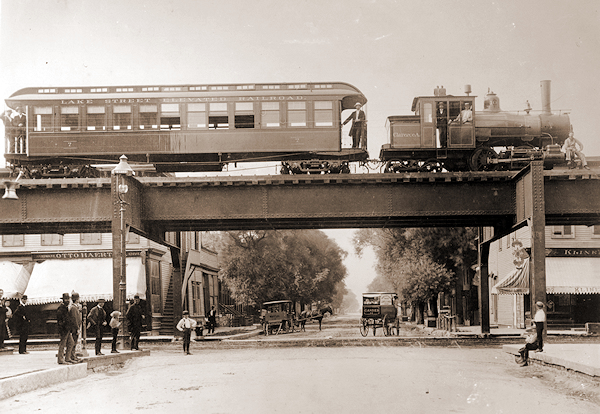
|
A Section of the Chicago Elevated Train in 1893.
Select to view larger size.
|

Chicago 1899
On November 23, 1899, dozens of newspapers across the United States printed a report of a horrifying accident that occurred the previous day in Chicago, Illinois. The victim, critically injured, would most likely die. His name was Andrew Lyren. He was sixty years old and described as a Swedish laborer who lived at 254 23rd Place, Chicago.
The papers related that at 4:30 in the afternoon of November 22, 1899, Andrew Lyren entered the Chicago elevated train station at 47th street. As the sun was setting on that cloudy fall day in the city, the man paid his fare and hurried upstairs to the northbound platform. When he reached the platform, the train was already in motion and the gates were closed.
He rushed to the edge of the platform and shouted to the gateman, W. Harper, who had charge of the two rear cars, "Let me on. Open the gates."
"Too late," replied the gateman, and the train whirled by.
Determined not to miss his train, Andrew Lyren grabbed the rear gate on the last car and attempted to climb aboard. Before he could succeed, the moving train had reached the end of the platform throwing him against the railing. The force of his contact with the guardrail was so great that it shattered a signboard and hurled him over the railing, falling face downward on the iron picket fence, which edged the track. The spikes of the fence penetrated his chest.
To the horror of the passengers, he remained impaled and suspended 20 feet above the ground until the train conductor W. E. Watrous, had stopped the train, and with several other spectators hurried to his assistance to remove and lay him on the ground. Three pickets had pierced his chest.
His rescuers took him nearly three miles north to Mercy hospital, where an examination showed that one of the spikes had penetrated the left lung, and another fractured the right shoulder blade. At a time before the discovery of antibiotics, his death was expected.
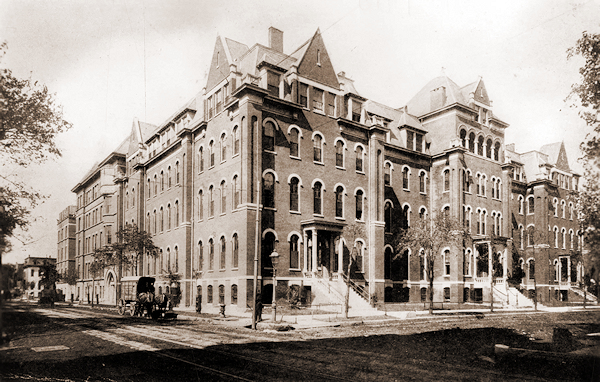
|
|
Mercy Hospital at 26th Street and Calumet Avenue, Chicago, about 1900. Select to view larger size.
|
More newspapers continued to print the sensational story around the United States throughout November and December 1899. The readers, however, never received the man's updated condition or the notice of his death.
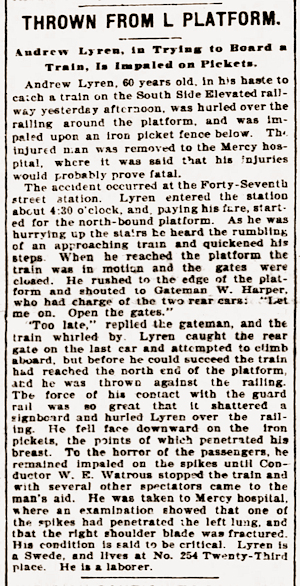
The Inter Ocean, Chicago, Illinois, Thursday, November 23, 1899, Page 3. Select to view larger size.
|
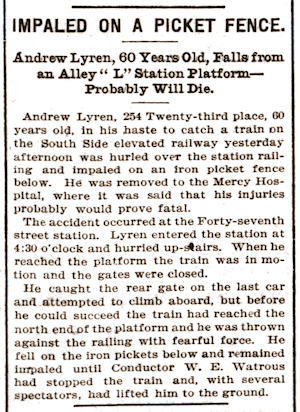
The Chicago Tribune, Chicago, Illinois, Thursday, November 23, 1899, Page 2. Select to view larger size.
These newspaper articles are referring to the train station that still exists today, situated at 314 E 47th Street, three blocks east of State Street, Chicago, Illinois. It opened in 1892, when South Side Elevated Railroad extended its service south to serve the 1893 Chicago World's Fair.
|
Was this Andrew Lyren of Chicago the same man as Andrew Lyrene who lived in Silverhill during the early Swedish colonization period?
Was there any way possible for him to have survived this ordeal and then lived many more years?
His descendants maintain they never heard of an accident in which their great grandfather Lyrene was involved.
Certainly, this appears to be a different individual. What evidence can validate this assertion?

Andrew Lyrene
Family belief, as told by Andrew Lyrene's grandson George Andrew Lyrene of Silverhill, states that the family name in Sweden was Pearson (Pierson, or Persson) and that George's father, Charles Magnus Lyrene, was born in Red Wing, Minnesota.
After much research, discoveries show that Andrew Lyrene was the first of the Silverhill Lyrenes to come to America. He was born Anders Persson in Sweden 1839 and died in Silverhill 1923 as Andrew Lyrene. He had only two children with his wife Märta Andersdotter. However, she had other children by a previous marriage. Andrew Lyrene's two sons were born in Sweden and both moved with their parents to Silverhill. Only one of those sons married and had children, which was Charles Magnus Lyrene.

Anders Perrson
Examining records from Sweden, a Lyrene connection to America becomes evident. One year before Anders Persson (aka Andrew Lyrene) traveled to America, his 18-year-old step-brother August Persson Berglund left Sweden for America on August 23, 1869. Also in 1869, Charles Edstrom moved to Red Wing, Minnesota. Charles Edstrom was the younger brother of Anders' future wife. Unmarried, Anders departed for America the next year on August 4, 1870, at the age of 30.
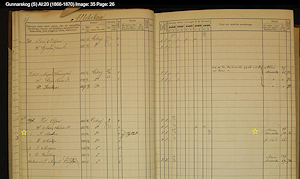
This is the 1866-1870 household church record for Allstakan, Gunnarskog parish, Värmlands, Sverige, top section of Page 26. Anders Persson was listed unmarried in his father's household and is marked with a yellow star. To the right of his name another star marks the date of August 4, 1870 when Anders traveled to America for the first time at the age of 30. Select to view larger size.
|
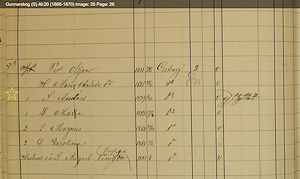
This is a close up of the left side of the same 1866-1870 household church record for Allstakan, Gunnarskog parish, Värmlands, Sverige, top section of Page 26. Anders Persson was listed unmarried in his father's household and is marked with a yellow star. The last person listed in the family was August Berglund who left for America on August 23, 1869 at the age of 18. Select to view larger size.
|
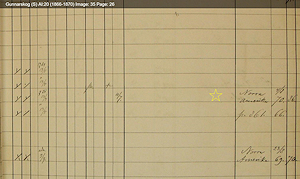
This is a close up of the right side of the same 1866-1870 household church record for Allstakan, Gunnarskog parish, Värmlands, Sverige, top section of Page 26. Anders Persson was listed unmarried in his father's household and is marked with a yellow star. The last person listed in the family was August Berglund who left for America on August 23, 1869 at the age of 18. Select to view larger size.
|
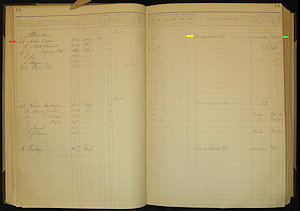
The 1881-1885 household church record for Allstakan, Gunnarskog parish, Värmlands, Sverige, Page 53. Anders Persson is marked with a red arrow. Working in America May 5, 1882 is marked in yellow. Moved to America November 4, 1883 is marked with a green arrow. Below his name are his wife, sons, and step-daughters. Select to view larger size.
|
After several months of working in America, Anders returned to his homeland of Sweden where he eventually married Märta Andersdotter on May 30, 1873. Märta was a widow with four young children. The same household record showed that Anders came back to work in America, leaving his wife and family in Sweden on May 5, 1882. By that time, Anders and Märta had two sons. Again, Anders traveled back to Sweden. Then the final international move on November 4, 1883, showed Anders Persson returning to America, this time with his family. The family included himself, his wife, his two sons, and one of his stepdaughters, Märta Olsdotter. In 1885, another of his stepdaughters moved to join them, Ingeborg Olsdotter.

The Name Change
Before 1900, Swedish surnames were mostly patronymic. These surnames were based on the father's given name and changed with each generation. The person's last name was derived from the father's given name and a suffix to identify the child's gender, -son or -dotter. For example, this Anders Persson was the son of Per Olsson. Per Olsson was the son of Olof Mattsson, who was the son of Mattes Eriksson, who was the son of Erik Mattsson. The wife of Anders Persson was Märta Andersdotter. She was the daughter of Anders Andersson. Women in Sweden at that time kept their surnames after they were married.
Read more here on Sweden Naming Customs.
Anders Persson used this name in Sweden, then used Andrew Lyren when he lived in America. Lyren and Lyrene were use interchangeably, then after decades, just Lyrene. His wife Märta Andersdotter, became Marta Lyren in America, and then Martha Lyrene.

Red Wing, Minnesota
When Andrew left Sweden for the last time on November 4, 1883 with his family, his youngest son Charles was five years old. Peter was nine years old. Red Wing, Minnesota must have been their first home, for years later, remembering the beauty of Red Wing, Peter told his nephew George of the grand view from the riverbank and his desire to visit that area once more.
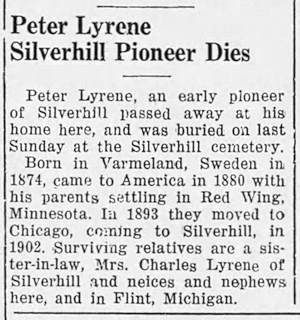
|
The 1952 obituary, printed in the Fairhope Courier about Peter Lyrene, gives more information of where the family had lived. The years written seem accurate except that Peter actually entered America in 1883 as previously confirmed above.
(Select to view larger size.)
|
Archives of the Evangelical Covenant Church in Red Wing, Minnesota lists a man named A. Lyren that was received into the church on August 10, 1884 and left on March 11, 1887. No other family members were listed with him. There is no way to be sure if this was the same man as Andrew Lyrene since no other information was given. Andrew's brother-in-law, Charles Edstrom, was also listed in this church register.

The Evangelical Covenant Church in Red Wing, Minnesota, Church Register, page 17. Lists A. Lyren, received Aug. 10, 1884; Excluded from the Assembly on March 11, 1887. Select to view larger size.
|
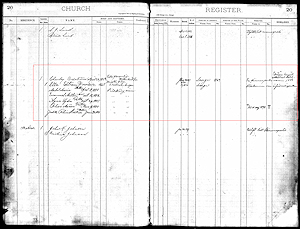
The Evangelical Covenant Church in Red Wing, Minnesota, Church Register, page 20. Lists Charley Edstrom, received April or June 30, 1887. Select to view larger size.
|
Peter Lyrene's obituary also mentioned that the family had relocated to Chicago in 1893. This year holds particular significance in the history of Chicago.

Chicago World's Fair 1893
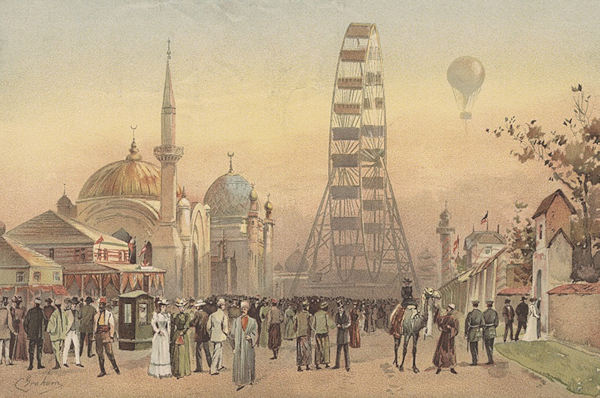
|
|
1893 Chicago World's Fair. - Select to view larger size.
|

Opened to the public in May 1893 for a duration of six months, the World's Columbian Exposition, also recognized as the Chicago World's Fair, marked the 400th anniversary of Columbus' voyage to North America. Constructed along Lake Michigan in Jackson Park, the exposition included two hundred buildings that housed exhibitions from over sixty countries along with the world's very first Ferris wheel.
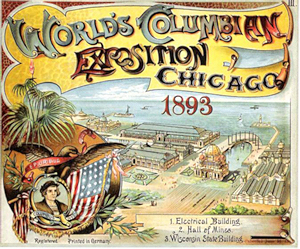
An advertisement for the Exposition, depicting a portrait of Christopher Columbus. Select to view larger size.
|
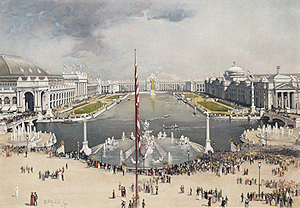
An artist's rendition of the Chicago World's Fair in 1893. Select to view larger size.
Go here to see a bird's eye view of the
World's Columbian Exposition, Chicago, 1893, including a directory of the buildings.
|
The fair occupied nearly 700 acres of land south of the heart of Chicago, taking 3 years to build. The structures were never intended to be permanent. Dismantling the large buildings took as much work as constructing, mostly by immigrant labor.
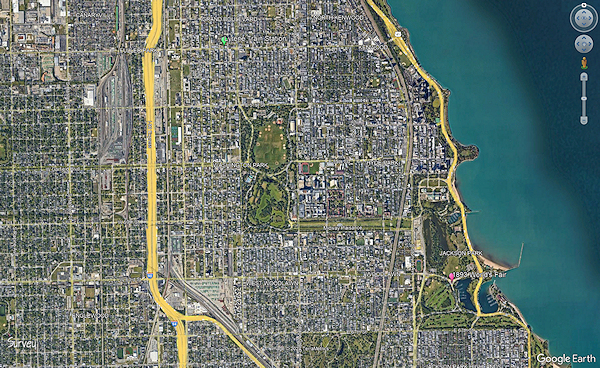
|
|
This 2024 map marks the location of the 1893 World's Fair in pink and the elevated train station at 47th street, where Andrew Lyren was injured, in green. The distance between the two markers is four miles. - Select to view larger size.
|
Chicago built the new elevated "L" train line to accommodate all of the visitors to the fair. The elevated train station at 47th street, where Andrew Lyren was injured, was one of the new stations.
Documented evidence of the Lyrene family in Chicago during the time of the World's Fair can be found in the Douglas Park Covenant Church archives.
This record lists a four-member family, excluding the husband. The first member of this family has the Swedish word "wife" written in front of the name Marta Lyren. Following her line to the right, are the Swedish words that translate, "Lives in Silver Hill Alab." Listed below her, are two daughters and one son, Magnus Lyren. They all came to the church on April 29, 1893.

The Douglas Park Covenant Church Register, Chicago, Illinois, page 110, photo copy. Select to view larger size.
|

The Douglas Park Covenant Church Register, Chicago, Illinois, page 110, typed and translated copy. Select to view larger size.
|
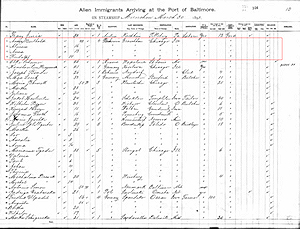
Manifest of the steamship Munchen. - Select to view larger size.
|
There is no information on a member of the Lyrene family working at or even visiting the fair. However, the fair did introduce a new branch to this family tree. Family legend holds that Charles Lyrene's future wife, Anna Berthold, and her family came in 1893 from Austria to work in the Chicago World's Fair.
|
Their ship's manifest above, shows that the Berthold family previously lived in Groschau, Czech Republic, and they were all born in Bohemia. Anna Berthold, listed here as the 13-year-old daughter, was able to speak fluent German, English, and Swedish, according to her son George. They migrated to America to represent their country in the Chicago World's Fair, which was possibly at the German building.
Joseph Berthold, their father, had arrived earlier than his family to secure living arrangements. Sadly, five years after the close of the fair, at the age of 49, Joseph died leaving his children to support his widow.

The Svea Land Colony
|
The Svea Land Colony organized in Chicago, Illinois in 1896.
The headquarters were in the Chicago Opera House Block building.
Many of the Swedes in Chicago were unhappy with the harsh working conditions and cramped housing. The dream of living in the country, growing their own food, and farming for their income was a strong desire among them.
|
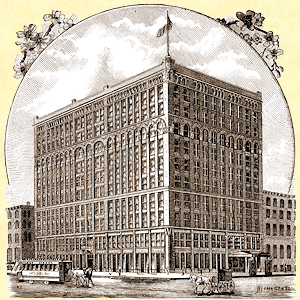
The 10 story Chicago Opera House held a theater and 240 offices.
|
The Svea Land Colony concept was to attract the Swedish-speaking population to form a pure Swedish colony. The group bought up large pieces of land in central Baldwin County. They wanted to form a town in the center of this land with larger parcels of land around the town for farms. They named the town Silverhill.
The Lyrene family likely belonged to those seeking to move away from Chicago. The following newspaper article names Andrew Lyrene as one of the land seekers in the excurtion to Baldwin County which occurred December 1897 through January 1898, not 1896 as incorrectly printed in the article. Andrew would have been 58 years old. The excurtion occured two years before the train accident in Chicago.
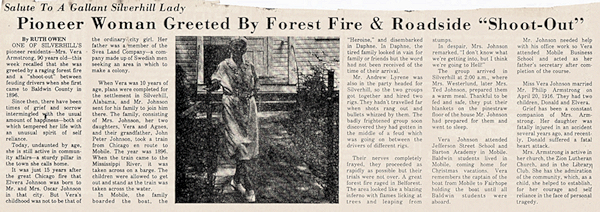
|
|
Vera Armstrong was the daughter of Oscar Johnson, the founder of Silverhill. In this article, written by Ruth Owen in 1977 for The Independent, Vera relates to the readers her first impression of Baldwin County and Silverhill when she was ten years old (born October 25, 1887, died May 29, 1985). She states that Andrew Lyrene was one of the travelers in her group from Chicago. - Select to view larger size.
|
The aritcle does not mention if anyone else from the Lyrene family came in that visit, but Andrew Lyrene must have had a favorible impression of the area. In 1901, his son Charles M. Lyren purchased 60 acres from the agents of the Svea Land Colony in Chicago.

Chicago 1900
The 1900 United States Census was collected in June of that year when the enumerators canvassed the entire nation. If the Lyrene family was living in Chicago at that time, they should have been noted in that record. Searches of that census found a four member family that the census taker wrote as having the family name of Lurane.
The 1900 United States Census, Chicago.
Lurane family
Select to view larger size.
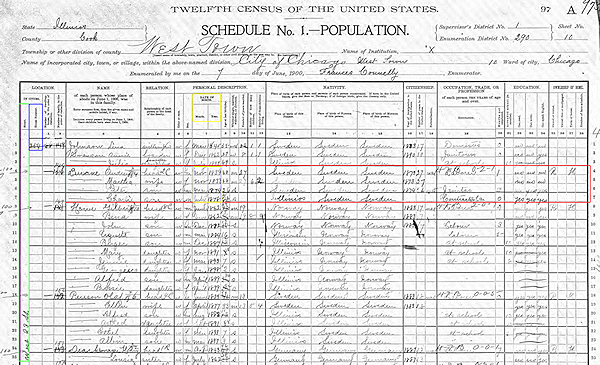
|
|
The area outlined in red is the Lurane family. Yellow outlines their dates of birth. Green outlines their street name. Blue outlines the house number. Six families were living in this house. The Lindberg family was noted as owning the house. The others were renting.
|
The head of this Lurane family was Andrew whose date of birth was noted as Nov 1839. His age was 60. His wife Martha had a date of birth of Nov 1833. These are the correct dates of birth for Andrew and Marta Lyrene. Two sons were also listed, Peter and Charlie.
The census notes that the house address was 254 West 23 St, Chicago.
The 1900 and 1901 Chicago City Directory lists two men with a last name Lyrane. Andrew was listed as a laborer and Peter as an engineer. Both had a house address of 254 W 23d, Chicago.
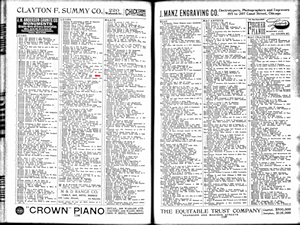
Chicago City Directory of 1900. The red arrow points to Lyrane. Select to view larger size.
|
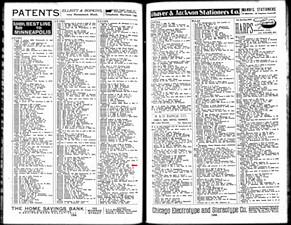
Chicago City Directory of 1901. The red arrow points to Lyrane. Select to view larger size.
|
The 1899 newspaper article of the train accident, said that the victim was a sixty-year-old Swedish laborer who lived at 254 23rd Place, Chicago. The census and the city directory of 1900 both list a man working as a laborer, living at a similar address whose name could be interpreted as Lyrene.
The fire insurance maps for Chicago in 1914 shows West 23rd Place and West 23rd Street next to each other. The one that has a house numbered 254 was on West 23rd Street.
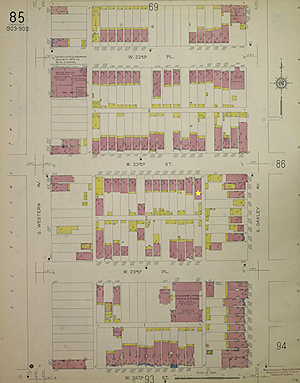
1914 Chicago Fire Insurance Map of West 23rd Street, Chicago. House number 254 is marked with a yellow star. The 1914 map has it renumbered to 2315, which is still in use today. Select to view larger size.
|
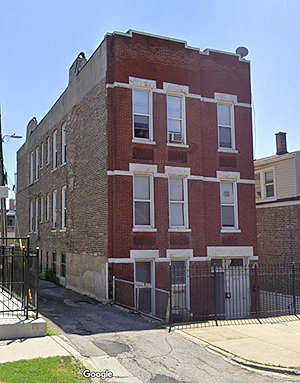
House number 254 West 23rd Street, Chicago is now 2315 W 23rd St. This was the home of the Lyrene family in 1900. The photo above was how it looked in 2019. Select to view larger size.
|
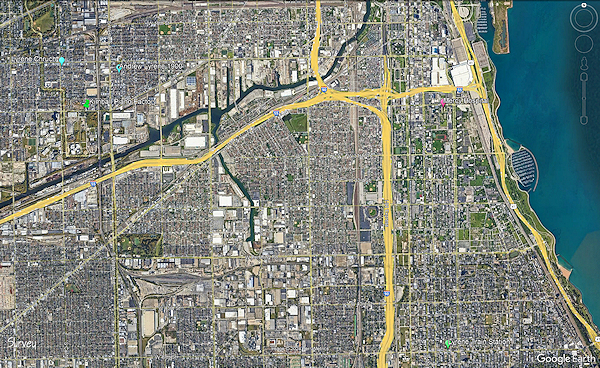
|
|
This 2024 map marks the following locations starting at the left side of the map: Blue pin - Lyrene Church (Douglas Park Covenant Church); green pin - Kimball Piano Factory; blue pin - Andrew Lyren house in 1900; pink pin - Mercy Hospital; bottom right, green pin - elevated train station at 47th street, site of the train accident. Select to view larger size.
|
It appears highly likely that Andrew Lyrene was indeed the same individual involved in the train accident in Chicago on November 22, 1899, as all the evidence suggests. Remarkably, he seemed to have survived the accident against all odds.

After the Train Accident
Andrew Lyrene undoubtedly owed his life to the heroic efforts of his rescuers and the skilled medical professionals at Chicago's Mercy Hospital. We may never know whether he remained hospitalized for weeks or if he was swiftly patched up and discharged to recover at home. His two sons were living in the same house and knew the accident occurred. For some reason, they never told their own sons or nephews about the incident.
The information on the Lurane family in the 1900 census, shows that Andrew was living at home in June and had been working as a laborer all but one of the twelve previous months. This would seem to indicate that he only took off one month from his job after that horrible accident.
Two years before the train accident, Andrew had visited Silverhill when Oscar Johnson's house was the only building in town. Two years after the train accident, on September 28, 1901, Andrew's youngest son, Charles M. Lyren purchased 60 acres from the agents of the Svea Land Colony in Chicago. The land was two miles west of the center of Silverhill. He paid five dollars an acre.
DEEDS
Lyren, Charles M., 20 acres, from Carl A. Vallentin for $100.
September 28, 1901.
~ A PDF File of the Document 
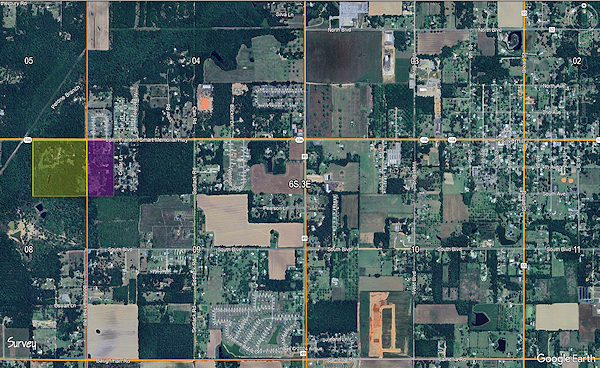
|
|
This 2024 map marks the land that Charles M. Lyren bought on September 28, 1901 from the land agents in Chicago. 40 acres in section 8 are highlighted in yellow that contain the springs that feed into the Perone Creek on the west side of the property. 20 acres in section 9 are highlighted in pink where the house was built. Select to view larger size.
|

A Lyrene Wedding
About this time, as the family story goes, Charles was living in his sister's boarding house while he worked at the Kimball piano company in Chicago. Anna Berthold was employed at the same boarding house, where she managed the laundry for one of the resident families. There, Anna and Charles met.
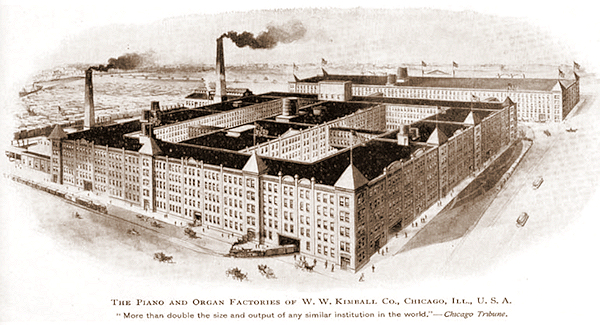
|
Kimball piano factory in Chicago, 1900. - Select to view larger size.
At the beginning of the 1880s, Kimball opened his first factory, which made organs and pianos, at 26th and Rockwell Streets in Chicago. By 1900, W. W. Kimball & Co. employed about 1,500 people at this facility. By the 1910s, the company was turning out more than 13,000 pianos each year, making it one of the top 10 manufacturers in the U.S. piano industry.
|
Anna Berthold's occupation was listed on the 1900 United States Census for Chicago as laundress. Below is the page which shows her living in an apartment with her mother and brother. By this time her father had died and her older sister had married.
The 1900 United States Census, Chicago.
Berthold family
Select to view larger size.
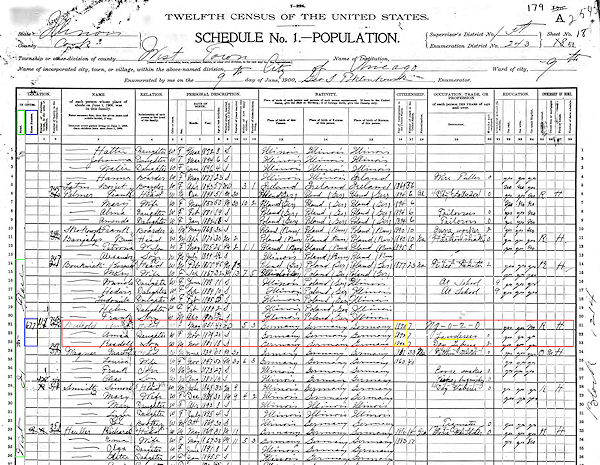
|
|
The area outlined in red is the Berthold family. Anna, the mother was listed as widowed. Yellow outlines their year of immigration. Green outlines their street name. Blue outlines the house number. Anna, the daughter had the occupation of laundress.
|
The census pictured above, notes that the Berthold house address in 1900 was 677 West 21st Place, Chicago.
Missing from the census was the father of this family Joseph Berthold who died in 1898. Two years before his death, he was listed in the 1896 Chicago City Directory (shown below left) with his occupation in ice. His residence was at 665 W. 21st Place in 1896.
The 1900 Chicago City Directory (shown below right) listed Anna Berthold as the widow of Joseph. Rudolph Berthold was listed as a laborer, and was living at the same address as Anna, his mother, 677 W. 21st Place.
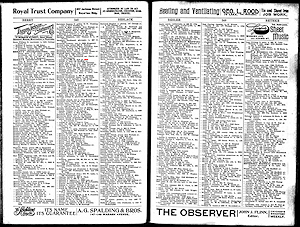
Chicago City Directory of 1896. The red arrow points to Joseph Berthold whose occupation was in ice. His residence was at 665 W. 21st Place. Select to view larger size.
|
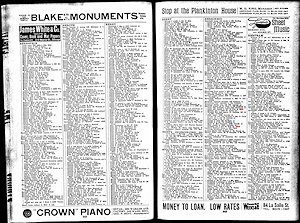
Chicago City Directory of 1900. The red arrow points to Anna Berthold who was listed as the widow of Joseph. Another red arrow points to Rudolph Berthold who was listed as a laborer living at the same address as Anna his mother, 677 W. 21st Place. Select to view larger size.
|
The fire insurance maps for Chicago in 1914 show West 21st Place. Several houses of interest were along that road. View the maps below.
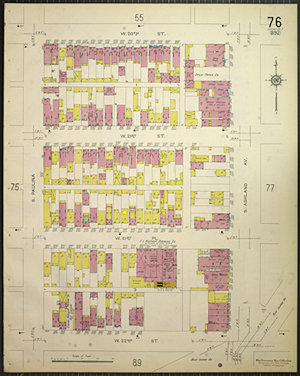
1914 Chicago Fire Insurance Map of West 21st Place, Chicago, IL.
The yellow star marks the Berthold house #665 in 1896 Chicago directory when Joseph was alive with the occupation of ice man. Select to view larger size.
The green star marks the Berthold house #677 in 1899 & 1900 Chicago directory when Joseph was dead, but son Rudolph lived with mother Anna. House #677 was also in the 1900 US census as the Berthold home. Select to view larger size.
|
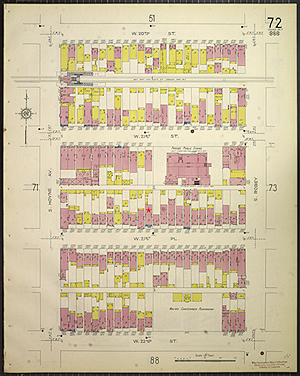
1914 Chicago Fire Insurance Map of 901 West 21st Place, Chicago, IL.
The red star marks the boarding house #901 in the 1900 US census where the Olson family had lived. Inga Olson, was the half-sister of Charles Lyrene. Select to view larger size.
|
The 1900 United States Census, Chicago.
Oscar Olson family
Select to view larger size.
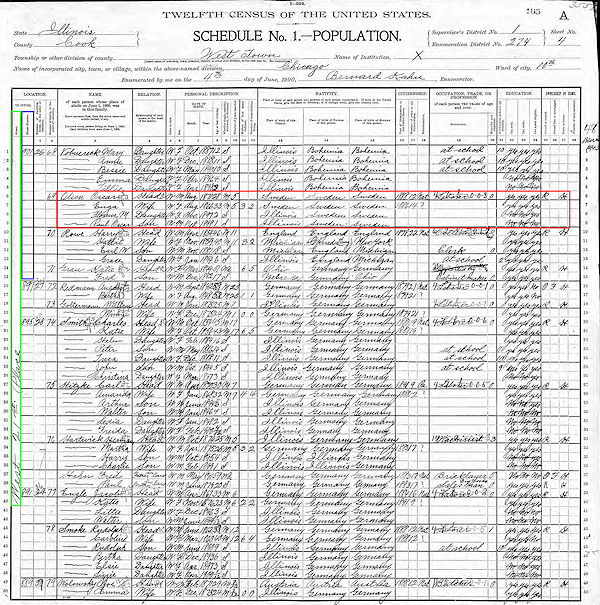
|
|
The area outlined in red is the Oscar Olson family. The wife, Inga Olson, was the half-sister of Charles Lyrene. This building was possibly the boarding house where Charles and Anna had met. The Olson family did not own the building, but were renting. Green outlines their street name. Blue outlines the house number. Their address was 901 West 21st Place, Chicago, IL, which is marked in the fire insurance map above right with a red star.
|
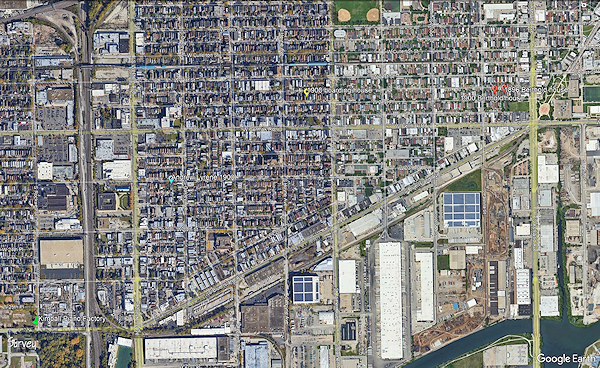
|
|
This 2024 map marks the following locations starting at the left side of the map: bottom left, green pin - Kimball Piano Factory in 1900; blue pin - Andrew Lyren house in 1900; yellow pin - boarding house where Charles and Anna met; red pin 2 - 1900 Berthold house; red pin 1 - 1896 Berthold house when their father was living. Select to view larger size.
|
At the age of 24, Charles Magnus Lyrene married Anna "Minnie E." Berthold on August 23, 1902 in Chicago, Illinois.
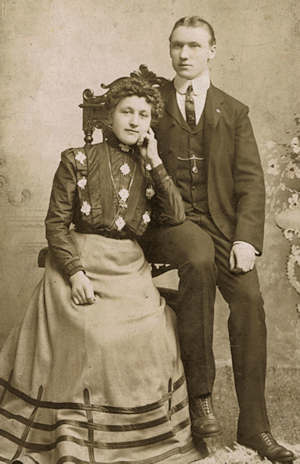
Anna and Charles Lyrene about 1902. (Select to view larger size.)
|
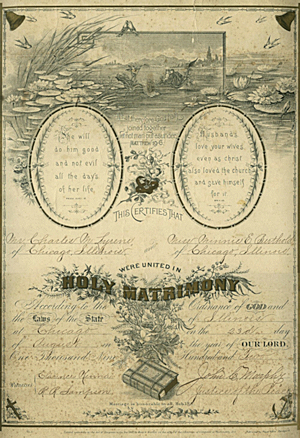
Anna and Charles Lyrene marriage certificate dated August 23, 1902. (Select to view larger size.)
|

The Lyrene Farm
A year before their wedding, Charles bought sixty acres of land west of the town of Silverhill. With the help of his brother Peter Lyrene and father Andrew Lyrene, Charles built a house on the land.
Anna's first child, Martha, was born in Chicago in October 1903. After the baby was thriving in 1904, mother and child took the long train ride to Baldwin County, Alabama to live in their new house on their farm.
In June 1906, Charles' mother Marta died in Silverhill, after a long sickness.

Printed in The Baldwin Times, Thursday June 14, 1906. (Select to view larger size.)
Local news was handwritten and mailed to the editor by Saturday of the week before they were published, making time sensitive news items a week old by the time of their printing.
|
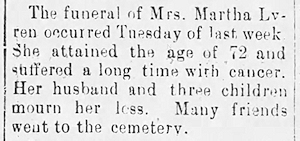
Printed in The Baldwin Times, Thursday June 21, 1906. (Select to view larger size.)
|
Charles and Anna's other children were born in Silverhill. Edna was born December 1906, Edward in June 1908, and George in November 1912.
Making the farm profitable was not easy.
As money ran out, Charles returned to his old job at the Kimball factory in Chicago, at times leaving his family behind, at other times, taking them with him to Chicago while his father and brother stayed to work on the Silverhill farm. Read more here on the Lyrene family and farm.

Charles M. Lyrene. Silverhill, Ala., April 14, 1907.
I have resided in Baldwin County about three years and in that time I have improved my health and strength. Always suffered from colds and other illness during the long and weary winters up North, while here we have perpetual summers. Sickness we have very little. The summers are not any hotter than they are up North, as we always have breezes from the Gulf. In mid-summer the nights are cool and a light covering is sometimes necessary.
The water is pure and there is plenty of it. The soil will produce almost everything and with a building up with barnyard manure it will produce wonderfully. We have several kinds of soil, but one is about as good as another. The farmers in
this section are going largely into trucking this year. We shipped some of the finest radishes up North with strawberries, cantaloupes, peaches, and other fruits and vegetables to follow. The farmers are very enthusiastic and they all think that this county has a
very bright future. What we need down here the most, is some more industrious farmers. I am well satisfied to make this my home, as I think it is a poor man's Paradise.
Click here to read more about Letters to the Louisville, and Nashville Railroad Company, from people who formerly lived north about Baldwin County, Ala.

1910 was one of the years when the farm could not support the family. On April 22, 1910, the census enumerator in Chicago listed Charles and his wife with three children living at 141 West 24th Place. It was possible that Anna gave the enumerator that information since Charles' place of birth was listed as Minnesota.
On April 27, 1910, the census enumerator in Baldwin County, Alabama, listed Charles and his wife with three children living next door to Andrew and Peter Lyrene. It was possible that Andrew gave the enumerator the information since Charles' place of birth was listed as Sweden. Charles and his family were probably in Chicago at the time.
The 1910 United States Census, Chicago.
Lyrene family on April 22, 1910
Select to view larger size.
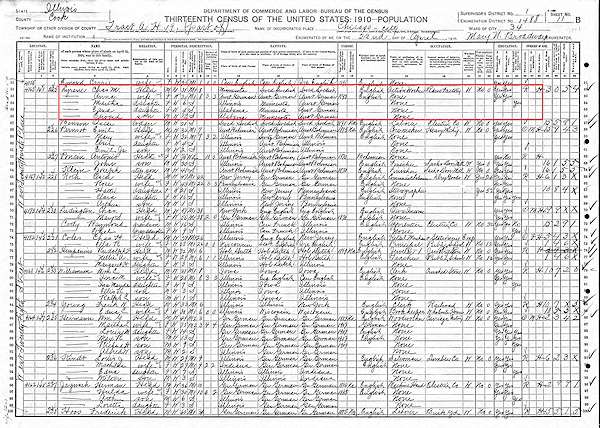
|
|
The area outlined in red is the Lyrene family. Charles M. had the occupation of action worker in a piano factory.
|
The 1910 United States Census, Silverhill.
Lyrene family on April 27, 1910
Select to view larger size.
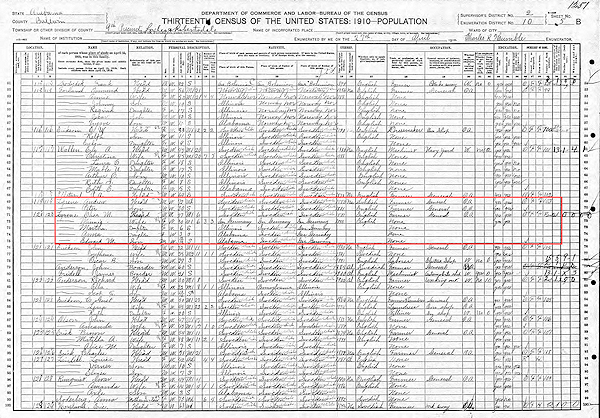
|
|
The area outlined in red is the Lyrene family. Charles M. had the occupation of farmer.
|
Eventually, the Lyrene farm became profitable, and the family remained in Silverhill. Charles M. Lyrene became a community leader helping to promote the growth of the Silverhill farmers and the town.
In 1909 Charles M. Lyrene was president of the local Farmers Educational and Cooperative Union of America.
In 1912 through 1919, Charles was a member of the Silverhill directors of the Peoples Railroad Company. In 1913 - 1919, Charles was elected president of the Silverhill Farmers Association, and served on its board of directors for many years. In 1921, he was on the board of directors for the charter group of the Baldwin County Farm Bureau, and also served on their Livestock committee. In 1923, he was on the board of directors for the beginning of the Baldwin County Fair Association. Also in 1923, he was one of the organizers of the State Bank of Silverhill. For several years including 1921 - 1925, Charles M. Lyrene was president of the Silverhill Community and Fair Association, after helping to organize and promote the fair beginning in 1917 and 1918. In 1925, Charles was one of three men to begin building the Silverhill Power Company a dam and a hydor-electric generating plant on Fish River.
During the early days of the Silverhill Elementary School, Anna Lyrene, Charles' wife helped to organize the School Improvement Association and continued to work with this group for many years afterward.
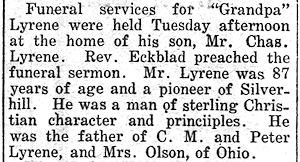
Above is a notice of the death of Andrew Lyrene printed May 24, 1923 in the The Onlooker of Foley.
On the right is an article printed July 12, 1923 in the Fairhope Courier that boasts about the Charles M. Lyrene farm.
Below is an article printed February 16, 1928 in the The Onlooker of Foley that tells about the Charles M. Lyrene farm.
|
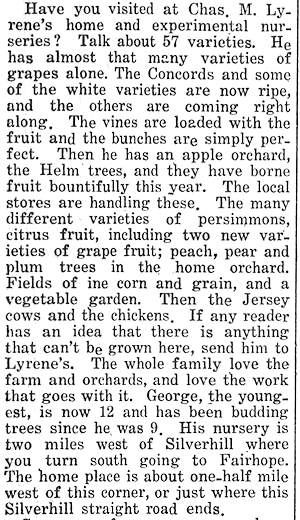
|
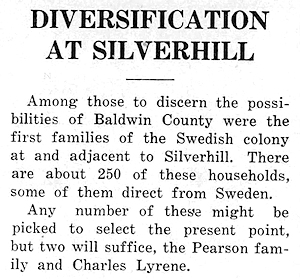
|
(Select to expand this article and view a larger size.)
|
Andrew Lyrene's hard work and persistence were important for his success, but they weren't the only things that mattered. He was flexible, learned from his mistakes, and took many risks to succeed.
He survived to help his family find a better life in a new place. His example showed them how to thrive.
Andrew Lyrene was born November 6, 1839 in Grafås, Gunnarskog, Värmland, Sverige. At the age of 83, he died on May 13, 1923 in Silverhill, Alabama, more than 23 years after the train accident in Chicago, Illinois.

|
|
|
|
Descendants of Andrew Lyrene (AKA Anders Perrson) |
|
|
|
|
|
|
|
|
|
|
Generation 1 |
|
|
|
|
1. ANDREW1 LYRENE (descended from: PerA Olsson, OlofB Mattsson, MattesC Eriksson, ErikD Mattsson) was born on 06 Nov 1839 in Grafås, Gunnarskog, Värmland, Sverige. He died on 13 May 1923 in Silverhill, Baldwin County, Alabama. His name at birth was Anders Persson.
Anders Persson married Märta Andersdotter on May 30, 1873 in Allstakan, Gunnarskog, Värmlands, Sverige.
Märta Andersdotter was born on 11 Nov 1833 in Fjell, Eda parish, Värmland, Sverige. She was the daughter of Anders Andersson and Märta Källarsdotter. She died on 10 June 1906 in Silverhill, Baldwin County, Alabama.
|
|
|
|
|
Andrew Lyrene and Märta Andersdotter had the following children: |
|
|
|
|
|
1.1. PETER ANDREW2 LYRENE (son of Andrew Lyrene and Märta Andersdotter) was born on 27 May 1874 in Allstakan, Gunnarskog parish, Värmlands, Sverige. He died on 04 Jan 1952 in Silverhill, Baldwin County, Alabama. He was never married and had no children. His name at birth was Per Andersson.
|
|
|
|
|
|
1.2. CHARLES MAGNUS LYRENE (son of Andrew Lyrene and Märta Andersdotter) was born on 05 Jul 1878 in Allstakan, Gunnarskog parish, Värmlands, Sverige. He died on 02 Dec 1943 in Silverhill, Baldwin County, Alabama. His name at birth was Magnus Andersson.
|
|
|
|
|
Generation 2 |
|
|
|
|
1.2. CHARLES MAGNUS2 LYRENE (descended from: Andrew1 Lyrene, PerA Olsson, OlofB Mattsson, MattesC Eriksson, ErikD Mattsson) was born on 05 Jul 1878 in Allstakan, Gunnarskog parish, Värmlands, Sverige. He died on 02 Dec 1943 in Silverhill, Baldwin County, Alabama.
Charles Magnus Lyrene married Anna Berthold on 23 Aug 1902 in Chicago, Cook County, Illinois.
She was born on 12 Nov 1879 in Groschau, Czech Republic (Bohemia). She died on 12 Jan 1962 in Silverhill, Baldwin County, Alabama.
|
|
|
|
|
Charles Magnus Lyrene and Anna Berthold had the following children: |
|
|
|
|
|
1.2.1. MARTHA A.3 LYRENE (daughter of Charles Magnus Lyrene and Anna Berthold) was born on 10 Oct 1903 in Chicago, Cook County, Illinois. She died on 25 Jul 1961 in Silverhill, Baldwin County, Alabama. She married James Swoboda. He was born on 16 Sep 1902 in Prague, Czechoslovakia. He died on 16 Oct 1977 in Foley, Baldwin County, Alabama.
|
|
|
|
|
|
1.2.2. EDNA ANNA LYRENE (daughter of Charles Magnus Lyrene and Anna Berthold) was born on 09 Dec 1906 in Silverhill, Baldwin County, Alabama. She died on 15 Nov 1995 in Silverhill, Baldwin County, Alabama. Edna Anna Lyrene married Frank John Sturma on 13 Feb 1929 in Escambia County, Florida. Frank John Sturma was born on 30 Nov 1907 in Tyndall, Bon Homme County, South Dakota. He died on 24 Jul 1957 in Silverhill, Baldwin County, Alabama.
|
|
|
|
|
|
1.2.3. EDWARD CHARLES LYRENE SR. (son of Charles Magnus Lyrene and Anna Berthold) was born on 28 Jun 1908 in Silverhill, Baldwin County, Alabama. He died on 20 Aug 1984 in Silverhill, Baldwin County, Alabama. Edward Charles Lyrene married Agnes Victoria Edhegard on 05 Nov 1940 in Silverhill, Baldwin County, Alabama. Agnes Victoria Edhegard was born on 02 Feb 1922 in Clovis, Curry County, New Mexico. She died on 07 Dec 1997 in Daphne, Baldwin County, Alabama.
|
|
|
|
|
|
1.2.4. GEORGE ANDREW LYRENE (son of Charles Magnus Lyrene and Anna Berthold) was born on 14 Nov 1912 in Silverhill, Baldwin County, Alabama. He died on 23 May 2002 in Daphne, Baldwin County, Alabama. George Andrew Lyrene married Florence Hazeltine Edhegard on 25 Aug 1943 in Silverhill, Baldwin County, Alabama. Florence Hazeltine Edhegard was born on 28 May 1925 in Manistee, Manistee, Michigan. She died on 08 Jun 2023 in Madison, Madison County, Alabama.
|

Written by Debbie Owen
June 2024

Resources
Ancestry website. U.S., Evangelical Covenant Church, Swedish American Church Records, 1868-1970. Douglas Park Covenant Church; Pages 752, 754, 739.
https://www.ancestry.com/
ChatGPT, ChatGPT 3.5 version, OpenAI, March - April 2024, "ChatGPT was used to revise content, and in the correction of spelling and grammar."
https://openai.com/
Newspapers website. The Baldwin Times of Bay Minette, Alabama, and The Fairhope Courier of Fairhope, Alabama, and The Onlooker of Foley, Alabama.
https://www.newspapers.com/
Sanborn Fire Insurance Maps from Chicago, Cook County, Illinois. Sanborn Map Company, Vol. 8, 1914. Map. Retrieved from the Library of Congress.
https://www.loc.gov/
Map of 254 W. 23rd St, Chicago, IL. Lyrene House in 1899-1901.
Map of 665 W. 21st Pl, Chicago, IL. Berthold House in 1896.
Map of 901 W. 21st Pl, Chicago, IL. Olson House in 1900.
W3C Spell Checker. Online tool that will check the spelling of a web page.
https://www.w3.org

|